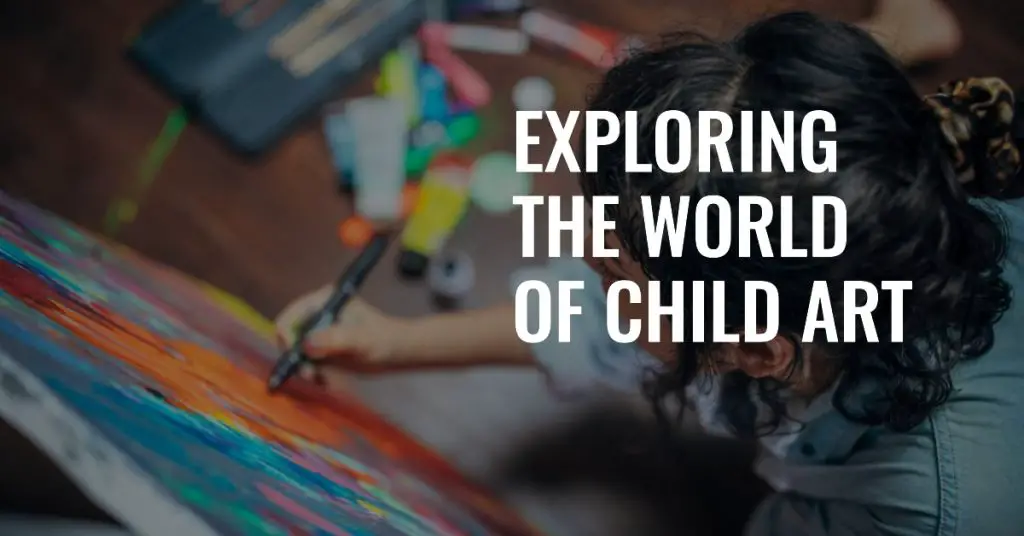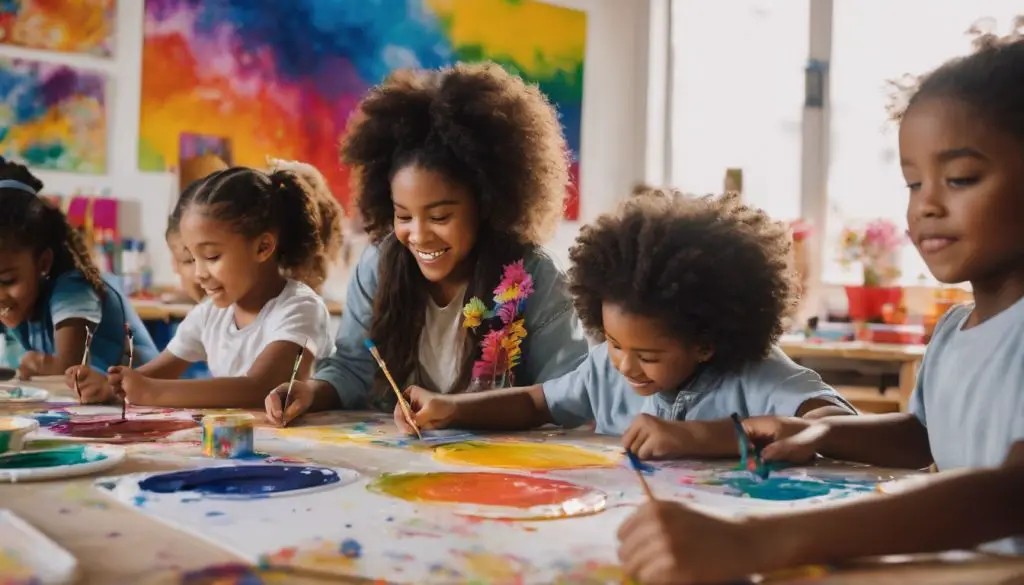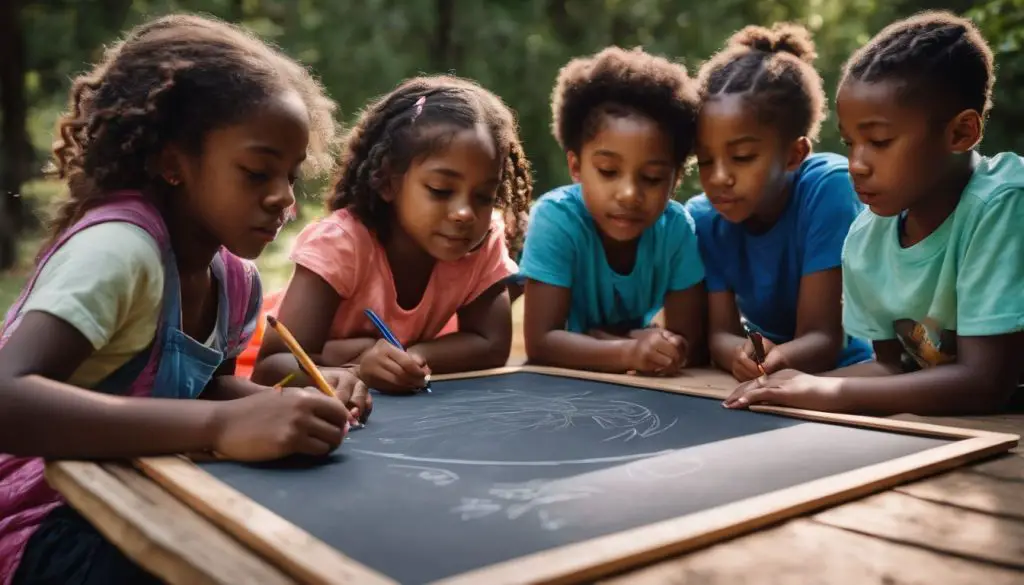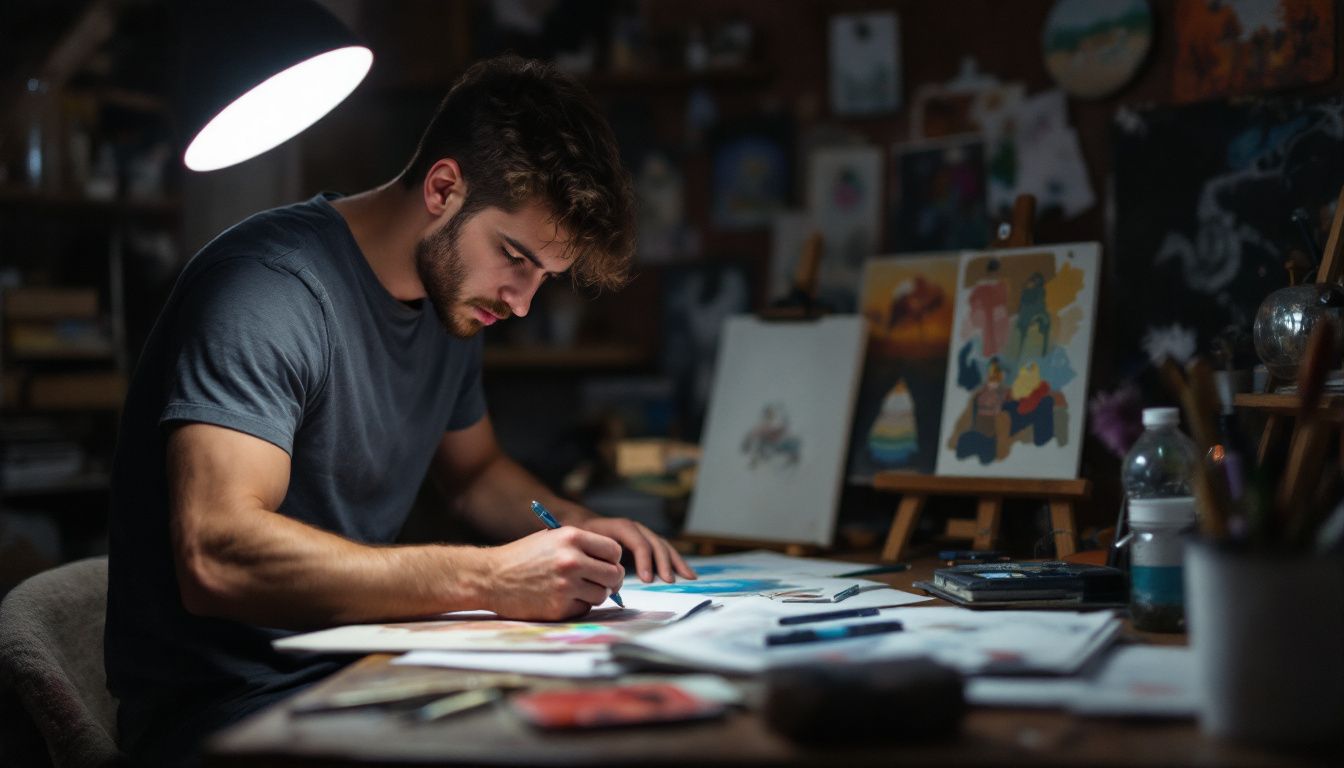The Stages And Characteristics Of Child Art

Have you ever marveled at the wild swirls and blobs in a child’s drawing, wondering what it all means?
Research shows that these early doodles are more than just random marks; they’re vital steps in a child’s cognitive and emotional development.
This guide will take you through each stage of artistic growth, from chaotic scribbles to detailed sketches, giving you an insider’s view into your little artist’s progress.
Get ready to see art through their eyes!
Key Takeaways
- Child art progresses through stages, starting with chaotic scribbles in the scribble stage (1-3 years old) and evolving into more purposeful representations in the decision stage (13-16 years old).
- At each stage of a child’s artistic development, from pre-schematic to pseudo-naturalistic, children show distinct characteristics reflecting their cognitive and emotional growth.
- Parents and educators play a crucial role in supporting children’s artistic development by encouraging creativity, providing access to materials for art activities, and valuing children’s artwork as an essential form of communication.
- Child art acts as a powerful tool for expressing emotions and fostering communication skills, allowing children to convey their thoughts and experiences through visual expression.
Table of Contents
Understanding Child Art

Understanding child art is essential for recognizing the importance and characteristics of children’s artistic development.
Definition of Child Art
Child art is the drawing and painting that kids do. It shows how they grow in their ability to make images.
From a young age, children use art to explore their world, share what they think and feel, and show their creative skills.
As kids get older, their drawings change. They start with simple scribbles when they are tiny. By the time they are around 2 or 3 years old, you can see accurate shapes in their artwork.
Artistic development happens in stages as children learn more about how to draw what they see and imagine.
Each stage has a fancy name, like the Scribbling stage or Schematic stage, and shows different ways kids understand shapes, people, and the world around them.
These stages help us know how children’s minds grow through art.
Importance of Child Art
Knowing why child art matters helps adults support kids as they grow. Art lets children share their thoughts and feelings without using words. It’s a way to talk about what’s in their minds or happening in their lives.
This is key for young ones who may not have the words yet.
Art also shows how kids see themselves and the world around them. When adults see this, they can give better help and praise. By valuing children’s artwork, we show that we care about their ideas and feelings.
This encourages them to be creative and confident in other parts of life too.
Characteristics of Child Art
Kids show their feelings and ideas through the way they make art. Their drawings often change as they get older. In the early stages, you might see simple scribbles or shapes that don’t look like real things.
This is because young children enjoy the movement of drawing. They have yet to try to make a picture.
As kids learn more about the world, their drawings start to have symbols for people and things they know. A child might use a circle for a face and lines for arms and legs.
Over time, these pictures get more detailed with colors that make sense and better shapes that show depth and space.
Kids also begin to care about making their artwork look “right” or realistic, especially as they move into later stages like dawning realism and pseudo-naturalistic stage, where detail and accuracy become very important to them.
The Stages of Child Artistic Development

Children go through different stages of artistic development, including the:
- Scribble stage (1-3 years old),
- Pre-schematic stage (3-4 years old),
- Schematic stage (5-6 years old),
- Dawning realism (7-9 years old),
- Pseudo-naturalistic stage (10-13 years old), and
- Decision stage (13-16 years old).
Scribble Stage (1 – 3 years old)
Toddlers between 1 to 3 years old go through the scribble stage, where they begin making their first marks on paper.
This is an essential milestone as it signifies the beginning of a child’s self-expression and exploration of possibilities.
These seemingly random lines and shapes are crucial for their cognitive development, motor skills, and emotional expression.
As children grow during this stage, their scribbles gradually become more controlled and intentional.
Moving on from the Scribble Stage, let’s now explore the next phase in a child’s artistic development – The Preschematic Stage (3 – 4 years old).
Preschematic Stage (3 – 4 years old)
Around 3-4 years old, children enter the pre-schematic stage of art development. At this phase, pre-symbolism emerges as they start combining circles and lines to draw human figures.
It’s a significant leap from simple scribbling as their motor abilities have improved, and they can now control lines and shapes more effectively.
As children progress through this stage, their perceptual and motor skills continue to develop, laying the foundation for more recognizable symbols in their artwork.
The ability to represent people, animals, and objects became clearer during this period, setting the stage for further artistic growth.
Schematic Stage (5 – 6 years old)
Children at the schematic stage, typically 5-6 years old, start to use more recognizable symbols in their drawings.
They may include a baseline in their artwork to organize objects in space, introducing a sense of order and perspective.
At this stage, children may also incorporate culturally-derived imagery into their art, such as drawing comic-book characters or sports heroes.
These developments show how children at this age are starting to represent their understanding of the world around them through art.
Their drawings reflect not only what they see but also how they interpret and organize visual information.
Moving on from the schematic stage is when children further refine these skills as they progress through their artistic development journey toward dawning realism.
Dawning Realism (7 – 9 years old)
At the dawning realism stage (7 – 9 years old), children focus on realistic representations and become aware of their limitations.
They start showing an understanding of perspective, three-dimensional effects, shading, and subtle color combinations in their artwork.
Around ages 9 or 10, they become more visually aware and include more details and proportions in their drawings.
As children enter this phase, they begin to incorporate more realistic representations and details in their artwork.
At this crucial stage, children’s artistic development progresses gradually through multiple stages simultaneously within a single drawing.
Pseudo-Naturalistic Stage (10 – 13 years old)
As children transition from the dawning realism stage, ages 7 to 9, they enter the pseudo-naturalistic stage between ages 10 to 13.
At this point, children become more focused on the final product of their art.
They start to recognize their limitations in representing reality accurately and may adopt cultural conventions for portraying three-dimensional scenes on a two-dimensional surface.
It’s also common for them to perceive color differently under various external conditions during this stage.
Decision Stage (13 – 16 years old)
At the Decision Stage, children start to explore a wider range of art forms and techniques. They begin to develop their unique artistic style, showing more attention to detail and using shading and perspective in their drawings.
As they become more self-aware, they may use art as a way to express their emotions and thoughts, reflecting their developing intellect and self-image.
At this stage, adolescents are likely influenced by popular culture and media in their artwork.
They often show interest in drawing subjects like comic-book characters or celebrities, integrating culturally-derived imagery into their artistic expression.
The Role of Adults in Supporting Child Artistic Development
Encouraging creativity, providing access to materials and resources, and valuing the child’s artwork are crucial in supporting a child’s artistic development.
Click here to learn more about the critical role adults play in nurturing children’s creativity.
Encouraging creativity
Encouraging creativity in children’s artistic development is crucial for their overall growth and self-expression.
Adults can support this by providing access to various art materials and tools, such as non-toxic markers, crayons, pencils, and watercolor paints.
It’s important to understand that children’s artistic development occurs gradually and can exhibit characteristics of multiple stages simultaneously in a single drawing.
Furthermore, valuing and displaying the child’s artwork plays a significant role in nurturing their confidence and creative expression.
Moving on to “Communication Through Child Art”.
Providing access to materials and resources
To support children’s artistic development, it is essential to provide them with access to a variety of art materials and resources.
Children benefit significantly from regular drawing activities and need the support of educators to foster their creativity.
Artistic expression through drawing helps in the development of hand-eye coordination, creative and mental growth, spatial relationships, and fine motor control.
Educators should ensure that children have ample opportunities to engage in art activities using various mediums such as crayons, markers, paints, and different types of paper.
Additionally, providing an environment where these materials are easily accessible allows young learners to explore their creativity freely while developing essential skills.
Valuing and displaying the child’s artwork
Once children have access to materials and resources for creating art, it’s equally important to value and display their artwork. By valuing their art, adults can communicate the significance of the child’s creative expression.
This can be done by praising specific aspects of their work and showing genuine interest in understanding the stories behind their creations.
Displaying a child’s artwork prominently at home or in educational settings not only boosts their confidence but also communicates that their efforts are valued.
When children’s artwork is showcased, it creates an environment where they feel heard and understood, fostering a sense of pride in their abilities to express themselves visually.
Moreover, displaying children’s art provides them with a tangible representation of their creativity and allows others to appreciate and acknowledge their unique perspectives.
Communication Through Child Art
Children use art as a means of expressing their emotions and developing their communication skills.
Expressing emotions
Children use art to express their emotions. Art allows them to convey feelings that they might find difficult to put into words.
Through drawing, painting, and other artistic activities, children can share their innermost thoughts and experiences in a way that is comfortable for them.
Artistic symbolism in child art serves as a powerful tool for emotional expression. It enables children to communicate complex sensations and subjective experiences through their creations.
For example, young children often use colors, shapes, and lines in their artwork to represent their emotions and the world around them.
This form of communication through art plays a significant role in supporting children’s emotional development.
Developing communication skills
Through their artwork, children enhance their communication skills by expressing themselves visually when words may fail them.
Art provides an avenue for children to convey their thoughts, feelings, and experiences.
As they manipulate art materials and create images, they develop the ability to communicate complex ideas and emotions non-verbally.
This process not only fosters self-expression but also encourages empathy and understanding in both the creators and viewers of the art.
Artistic activities enable children to communicate beyond language barriers, allowing them to express themselves in a way that is universally understood.
By engaging in art creation, children strengthen their ability to interpret visual cues and understand emotions conveyed through imagery, contributing significantly to their overall communication proficiency.
Art and Self-Image
Art plays a crucial role in developing a child’s self-image and how they perceive themselves through their artwork.
Role of art in developing self-image
Children use art as a way to express how they see themselves. Self-portraits by young children show their self-image and self-expression.
Through art, children can communicate their emotions and thoughts about themselves when words are not enough.
Art helps in developing self-awareness in children. It allows them to explore and represent their perspectives, feelings, and experiences visually.
This visual communication through art aids in shaping a child’s understanding of themselves and the world around them.
How children perceive themselves through their artwork
Art serves as a mirror reflecting children’s self-image and emotions. As children create art, they often convey through it what they cannot articulate in words.
This process enables them to explore their thoughts, feelings, and understanding of themselves.
Their early representations of the human body in art may give insight into their growing self-awareness and perception.
Children’s artwork becomes an avenue for them to express their evolving identity and emotions, offering adults a glimpse into the child’s inner world.
Through art, children often depict aspects of themselves that they are unable to communicate verbally, providing valuable clues for adults supporting their holistic development.
Source URLs:
- https://funchildhood.com/a-childs-drawing/#:~:text=we%20have%20four%20stages%20of,made%20in%20the%20later%20stages.
- https://thevirtualinstructor.com/blog/the-stages-of-artistic-development
- https://www.d.umn.edu/artedu/lowenf.html



Leave a Reply